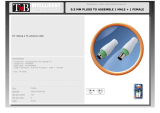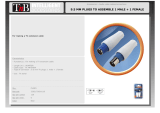
Table of Contents
List of Tables
Table 1: Run mode ................................................................................................. 2
Table 2: Arbitrary waveform...................................................................................... 2
Table 3: Real time digital signal processing..................................................................... 3
Table 4: Sequencer ................................................................................................. 3
Table 5: Sample clock generator.................................................................................. 4
Table 6: Analog output skew...................................................................................... 4
Table 7: Signal output characteristics ............................................................................ 5
Table 8: Harmonic distortion (DC High
BW output path).................................................... 11
Table 9: Harmonic distortion (AC Direct output path)........................................................ 12
Table 10: Harmonic distortion (AC Amplified output path).................................................. 12
Table 11: SFDR operating at 2.5 GS/s .......................................................................... 12
Table 12: SFDR operating at 5 GS/s ............................................................................ 13
Table 13: SFDR operating at 10 GS/s........................................................................... 13
Table 14: Phase noise operating at 2.5 GS/s.................................................................... 14
Table 15: Phase noise at 5.0 GS/s or 10 GS/s with DDR enabled ........................................... 14
Table 16: Marker outputs......................................................................................... 14
Table 17: 10 MHz Ref Out (reference output) ................................................................. 15
Table 18: Ref In (reference input) ............................................................................... 15
Table 19: Clock Out............................................................................................... 15
Table 20: Clock In................................................................................................. 16
Table 21: Sync In.................................................................................................. 16
Table 22: Sync Out ................................................................................................ 16
Table 23: Sync Clock Out ........................................................................................ 17
Table 24: Trigger Inputs .......................................................................................... 17
Table 25: Pattern Jump In connector ............................................................................ 19
Table 26: Auxiliary Outputs (Flags)..... ...................... ...... ...................... ...... ................ 20
Table 27: Computer
system ...................................................................................... 20
Table 28: Display.................................................................................................. 20
Table 29: Power supply........................................................................................... 21
Table 30: Mechanical characteristics............................................................................ 21
Table 31: Environmental characteristics ........................................................................ 23
Table 32: Required equipment for the functional test ......................................................... 30
Table 33: Required equipment for performance tests ......................................................... 43
Table 34: Analog amplitude accuracy (DC High BW output path).............................. .......... .. 46
Table 35: Offset accuracy ........................................................................................ 50
Table 36: Analog DC bias accuracy............................................................................. 53
Table 37: Marker high level accuracy........................................................................... 57
Table 38: Marker low level accuracy............................................................................ 58
AWG5200 Series Technical Reference iii























